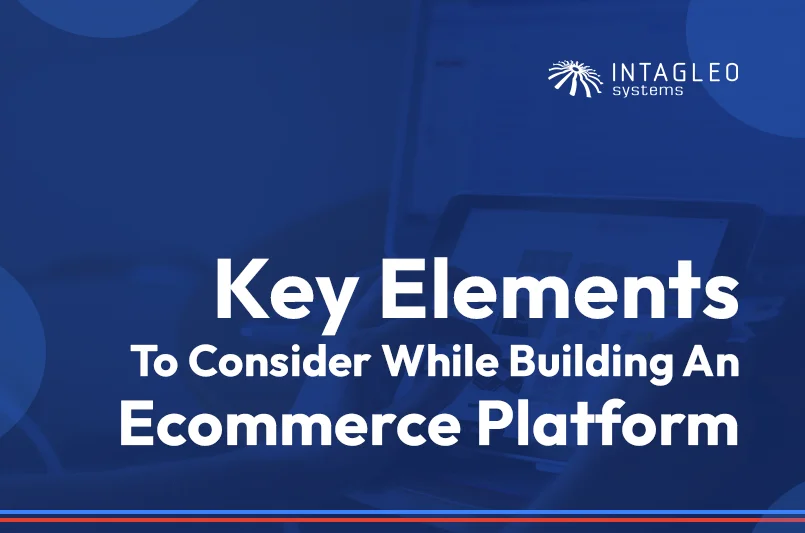An engagement model is a set of rules and obligations that lays down the basis of the relationship between you and your software vendor for the duration of your project. It dictates everything from how you will collaborate to how payments will be handled to how much control you’ll have, but more on that in a bit. What’s important to understand, for now, is choosing the right engagement model is a big decision, detrimental to your project’s success.
Some of the most common engagement model examples include Fixed Price, Time and Materials, and the Dedicated Team Model. We’ll kick things off with each model’s specifics and pros and cons. If you’re already familiar with these, feel free to skip ahead to the last section and check out our considerations for choosing the right engagement model for your project needs.
Let’s begin!
Fixed Price Model
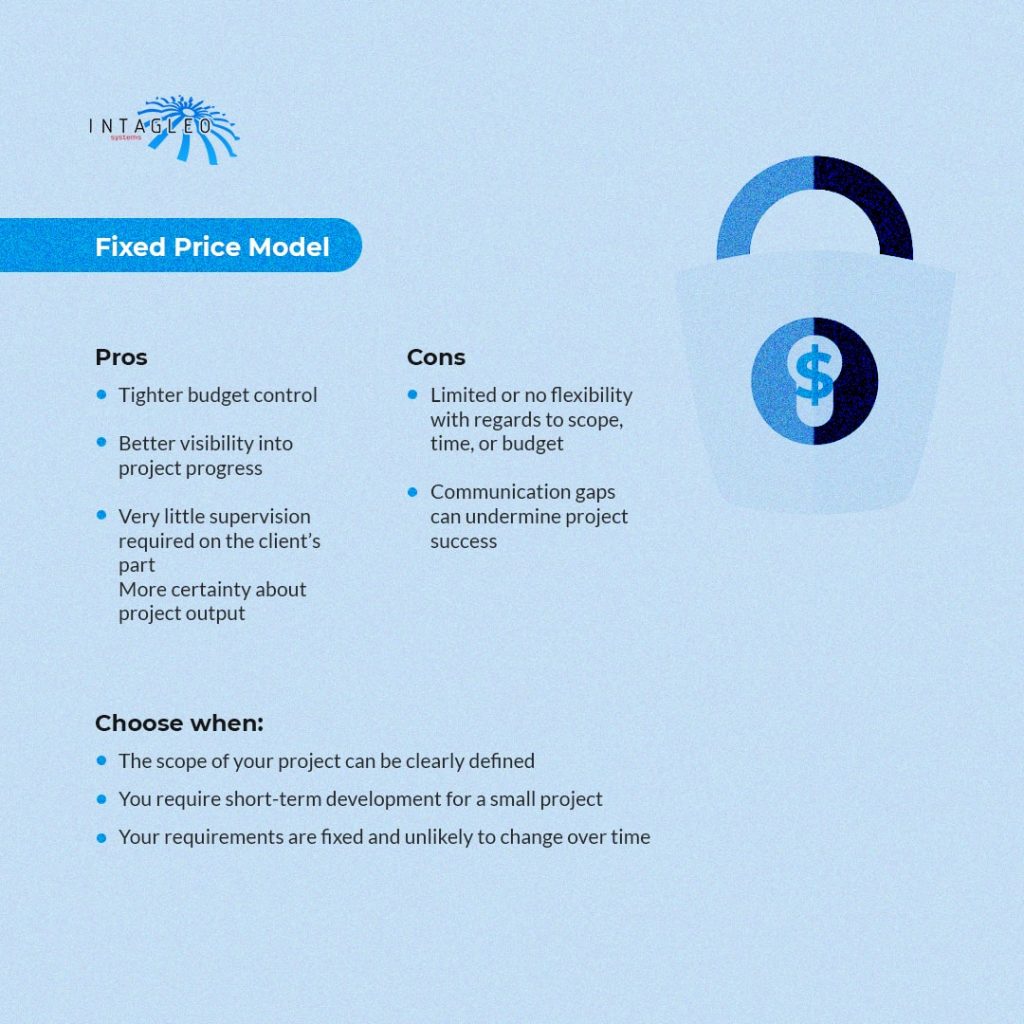
This model is characterized by predefined project requirements, set time frames, and a fixed budget. Here at Intagleo, you provide us with your precise requirements, and we discuss them with you at great length, making sure no vital detail slips through the cracks. After carefully scoping your needs, we then get back to you with a proposal detailing the set price, project deliverables, timelines, etc. As soon as an agreement is reached, development begins on your project in strict compliance with the proposal with very little room for deviation.
Pros of the Fixed Price Model
Tighter Control Over Budget
Like other aspects of your project, the cost is also defined upfront in the Fixed Price engagement model. We at Intagleo come up with a suitable number after careful deliberation and considering what will be needed to complete your project successfully. This means you know exactly how much you’ll have to dish out, right from the get-go, and only once you agree to our offer, will any actual work begin on your project.
Moreover, there are no hidden or extra costs. You only pay for what you receive, as agreed upon in the initial scope, so you never go over budget.
Better Visibility into Project Progress
The Fixed Price Model affords you greater predictability in terms of project deadlines and milestone deliverables, compared to other options. When we initially scope your project, we make sure to define all of its specifications and propose a timeline of how and when we’ll deliver each of your required features in different phases of the project. All of our suggested deadlines are approved by you in advance so you know how your project’s going to progress over time and when it’s going to be complete with a great deal of precision.
Very Little Supervision Required On the Client’s Part
Since all your requirements and specifications are defined beforehand, there’s very little you need to do once your project begins. Our competent project managers make sure that everything is executed exactly in the way you intended and as agreed upon initially. This can be great news if you’re someone who doesn’t like being very hands-on with their projects.
More Certainty About Project Output
Even from the very beginning, we make sure you’re aware of exactly what features and capabilities your final product will have, what it will look like, and how it will be developed. Thus, you can plan accordingly and focus on the other vital tasks, safe in the knowledge that there will be no uncertainties or surprises when it comes to the final outcome of your project.
Cons of the Fixed Price Model
Limited or No Flexibility
As we said, the client has very little to do once the project is underway, but it’s only because there’s not much they can do as all their initially approved requirements are practically set in stone in the Fixed Price Model.
You, as a client, have very little recourse if you decide to change your mind about some feature a few months down the line. In such a case, your only options are to stick with the original plan or undergo the scoping process again and renegotiate price and deadlines, resulting in additional expenses.
Communication Gaps Can Undermine Project Success
Along the lines of the discussion above, it’s extremely vital that you have a clear understanding of your exact needs and are able to communicate them effectively to your software vendor. Failure to do so will inevitably lead to the final product not meeting your expectations.
To avoid this, our experts take the time to precisely map out all your requirements and document everything to weed out any inconsistencies and ensure everyone’s on the same page.
Time and Materials Model
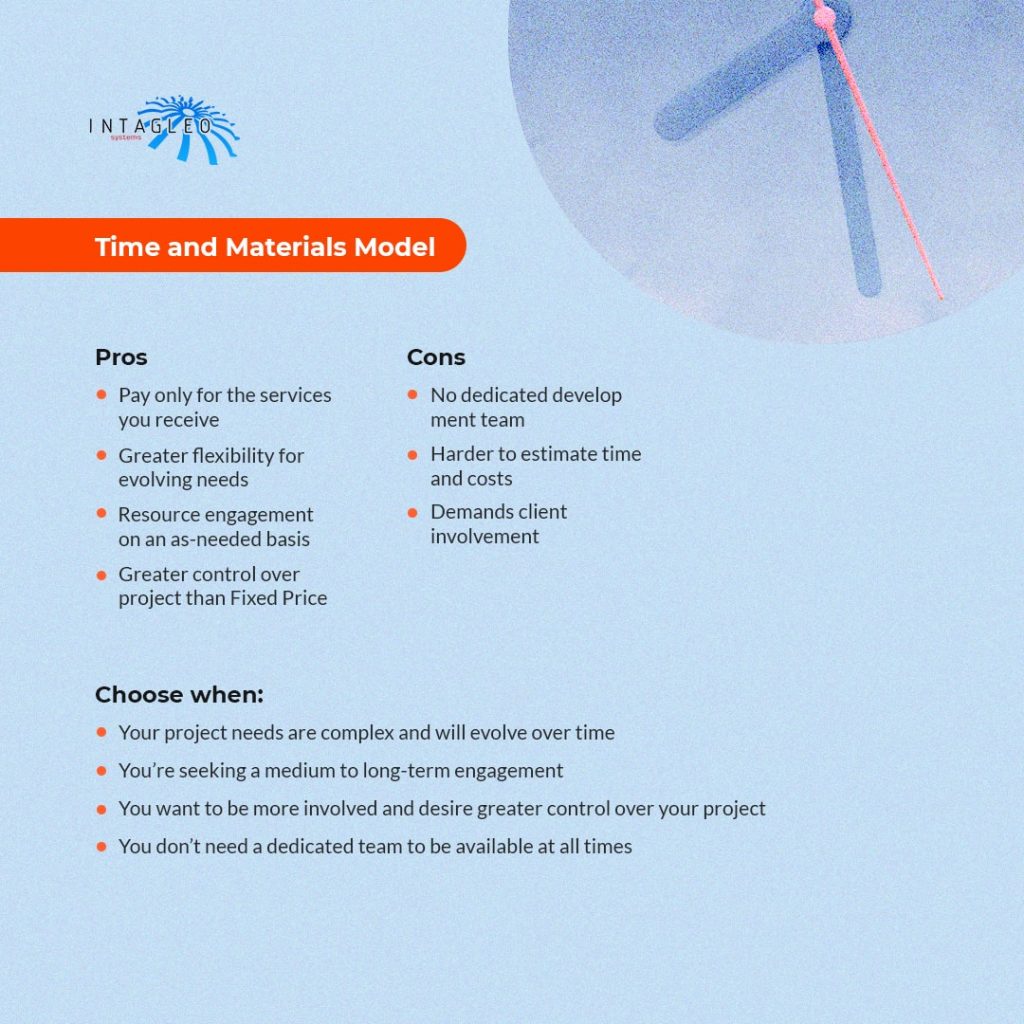
Time and Materials is the most adaptive out of three main models discussed in this article and used for projects without a clear scope. The client and vendor agree on a fixed unit of time (usually an hourly rate) before commencing any actual work. Payments are usually made monthly, after the vendor reports on the man-hours and resources spent on the project thus far.
The development process tends to be more iterative this time around with greater engagement and possibility of more feature requests from the client but at the cost of predictability.
This model also equitably distributes the risks involved among both parties, with the client only paying for the time spent on project implementation, and the vendor always getting paid for any extra effort they’ve put in.
Pros of the Time and Materials Model
Pay Only for What You Get
In this model, you only pay for the time and resources spent on your project by the software vendor, nothing more, nothing less. The cost is calculated by multiplying the exact number of productive man-hours spent on your project with an agreed-upon hourly rate. Any additional expenses incurred during development are also added to this number.
Greater Flexibility for Evolving Needs
Time and Materials offers a great deal of flexibility when it comes to feature requests, and budget negotiations, translating into a lower risk for both the vendor and the client. You can easily make changes to your requirements or the workflow and have your vendor implement new features and upgrades practically on-demand, without having to worry about your budget. This helps you be more responsive to changing market perceptions and emerging technological trends.
Resource Engagement on an As-needed Basis
You have complete say over what period of time you’d like to have the development team work on your project. You can work out a development schedule with your vendor and swing back and forth between development and other tasks with ease to focus on what’s more important. If for any given time period, you don’t need any features developed or don’t want to pay the team, you can easily put them on standby and continue from where you left off down the road.
More Control Over Project
In the Time and Materials model, you get to be more involved through every stage of development, closely monitor progress, and interact with the team, making the process more transparent and better at bridging communication gaps compared to the Fixed Price Model. As a result, all your current and changing needs are clearly defined and understood by developers, ensuring the final outcome is in-line with your expectations.
Cons of the Time and Materials Model
No Dedicated Development Team
While some may find having an on-again, off-again relationship with their software vendor in a Time and Materials Engagement model convenient, there is no guarantee they’ll have the same people working with them again. Often, these experts are working for other clients, and it’s not possible for the vendor to quickly assign them to you.
In such a case, you can either wait for these individuals to wrap their ongoing projects, or have a new team take over. The only to ensure that the same people consistently work on your project is by opting for a Dedicated Team Model.
Harder to Estimate Time and Costs
This engagement model is chosen when the scope of the project can’t be fully defined. Without any clear specifications, it’s hard to come up with precise time and budget estimates in advance. Therefore, contrary to the Fixed Price Model, the final cost and project completion time can vary considerably from these initial estimates depending on how many features, changes or upgrades, you have the development team implement.
Demands Client Involvement
To ensure your software vendor understands your evolving aims and needs, it is vital that you clearly and frequently communicate these to them and keep a close eye on your project’s progress. While this is definitely more effort on your part, the final product will likely be more in line with your expectations and offer better value overall.
Dedicated Team Model
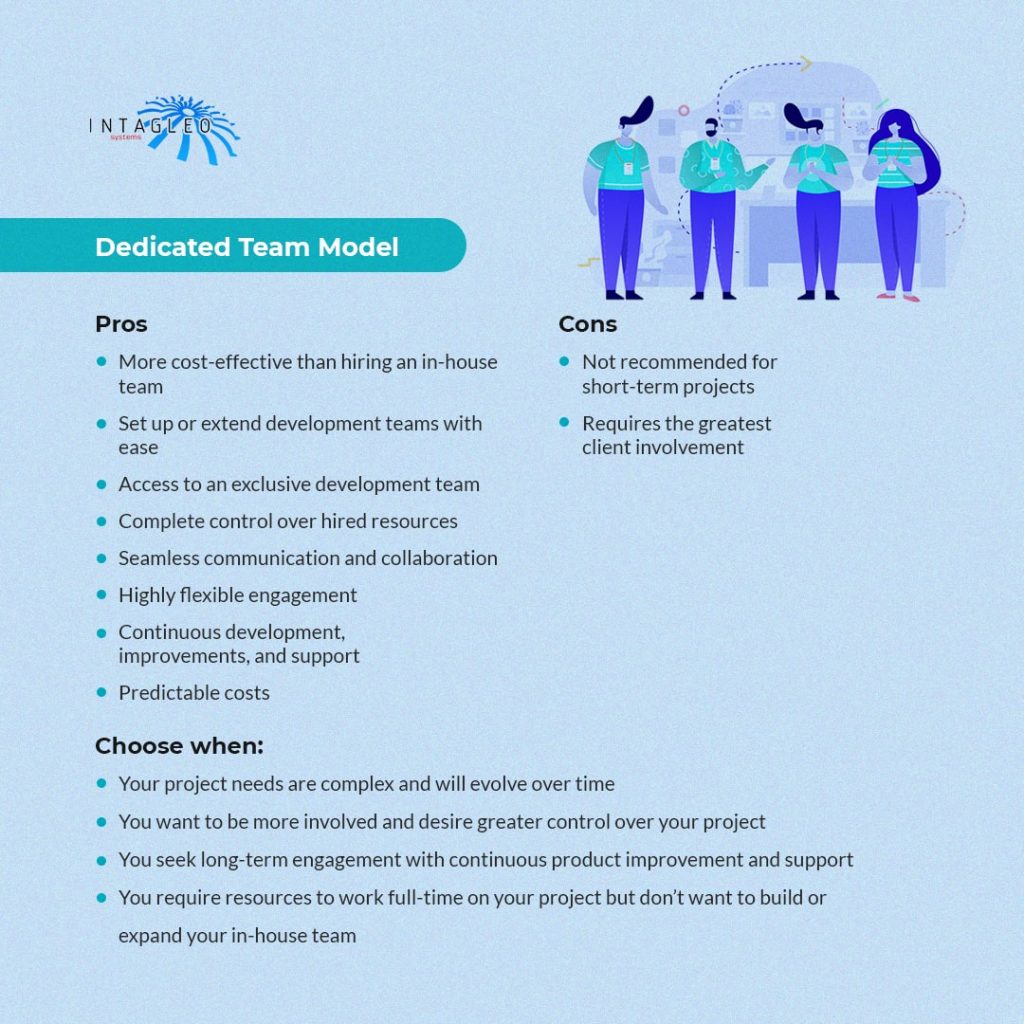
Also known as Staff Augmentation, this model gives you access to a dedicated team that works full-time only on your projects, functioning as an extension of your in-house team. In addition to developers, we can provide you with Project Managers, QA Engineers, UI/UX designers, and more depending on the skills and expertise required. Payments typically encompass your hired resources’ salaries and the vendor’s fees and are made at a predefined, agreed-upon frequency (daily, monthly, etc.) and rate (varies for each type of resource).
Initially, high-level requirements (e.g., the project scope, required expertise), timeframes, and the general vision are identified, and once an agreement is reached, actual work starts on the project.
Pros of the Dedicated Team Model
More Cost-effective than Hiring an In-house Team
Our Dedicated Team Model is a great option for anyone looking for talented experts to work full-time on their project, but don’t want the hassle of maintaining an in-house team, partly because of the huge sums of money involved.
When you choose our Dedicated Team Model, you only have to pay our experts an hourly wage for the amount of time for which you’ve contracted them. Meanwhile, we take care of all the other expenses like hiring, onboarding, training, entitlements, and so on.
Plug and Play Solution for Setting up or Extending Teams
If you haven’t the slightest idea about what to look for when hiring specialists for your projects, then the Dedicated Team Model is the perfect choice for you. For the hiring and onboarding part, you can kick back and relax while we assemble your dream team keeping in mind your exact needs as well as the expertise required to tackle your project. In addition to hiring resources for the first time, it’s also a great option if you need to scale-up your existing team.
Access to an Exclusive Development Team
If you haven’t guessed it already, this model gives you access to expert resources that work exclusively on your project and nothing else. By giving it their undivided attention and the utmost importance that it deserves, our experts are able to deliver optimal results. You can hire dedicated experts for the entirety of your project’s duration or choose to reconfigure the team for various phases of development.
Complete Control Over Hired Resources
Compared to Fixed Price and Time and Materials, this model gives you unprecedented control over how you manage and coordinate the external resources at your disposal and the overall project.
In a Dedicated Team Model, although the resources you contract are our permanent employees, we mainly take care of the HR and administrative aspects. You get to approve who gets to work on your project, and as far as managing them is concerned, they practically function as a seamless extension of your in-house team. This means they’re subject to the same organizational rules, regulations, and policies as the rest of your employees.
Seamless Communication and Collaboration
The Dedicated Team Model provides you constant and direct communication with your hired resources, allowing for more effective planning and better visibility into each and every aspect of your project. You’re able to get your expectations across more effectively and ensure that the final product meets them perfectly.
To further facilitate communication, we at Intagleo provide free dedicated Project Managers and Quality Assurance Engineers for all new projects for the first few months. Moreover, we make use of effective communication tools (i.e., video conferencing tools, instant messaging platforms, project management software) to simplify collaboration and help you exercise greater control over the project.
Highly Flexible Engagement
The Dedicated Team Model takes the flexibility of Time and Materials and takes it up a notch. You can modify the scope of your project at any stage without having to worry about losing time or money. Your hired resources are only answerable to you. If there’s a change in your priorities, workflows, or goals, you simply need to communicate these to the team, and they’ll proceed accordingly.
Continuous Development, Improvements, and Support
Having a dedicated team allows for the continuous development of your project. You can have your hired resources enrich your custom software product and expand its capabilities keeping in mind customer feedback and changing market trends. Moreover, since the team is working exclusively and closely on your project, they can master all its ins-and-outs completely, prompting them to better support and maintain your product in the long run.
Predictable Costs
Based on negotiations with your vendor, you’re required to pay a fixed sum of money each month for acquiring the services of their professionals in the Dedicated Team Model. While this is not as clear-cut as the Fixed Price Model, it does give you an idea of how much you’ll have to spend each month, offering you better visibility into your finances and allowing you to plan ahead.
Cons of the Dedicated Team Model
Not Recommended for Short-term Projects
We don’t recommend the Dedicated Team Model for short-term projects. Firstly, most of the benefits that come with this model are rendered moot if your project is short-term. For such a duration, you probably don’t need exclusive developers to work on your project and would be better off opting for the Fixed Price Model.
Moreover, you’ll likely have to forego any opportunities for the exchange of ideas, mutual learning, and continuous improvement as the time limit severely restricts them.
Dedicated engagement also tends to be pricier than other models, and while this doesn’t stick out in the long-term, you’ll certainly find it unfeasible in the short-term.
Requires the Greatest Client Involvement
While granting you the most control, the Dedicated Team Model demands the most involvement from you as well. In addition to managing the project, you’ll also be managing and frequently communicating with your extended team as well as making sure they get along with your in-house team.
Having the right technology partner can really make a difference in this regard. Fortunately, we’re here to back you up. Our experts know what it takes to seamlessly augment your in-house team, minimizing any conflicts of interest and maximizing productivity.
Determining the Right Engagement Model for Your Project
Choose the Fixed Price Model When:
- The scope of your project can be clearly defined.
- You require short-term development for a small project.
- Your requirements are fixed and unlikely to change over time.
Choose the Time and Materials Model When:
- Your project needs are complex and will evolve over time.
- You’re seeking a medium to long-term engagement.
- You want to be more involved and desire greater control over your project.
- You don’t need a dedicated team to be available at all times.
Choose the Dedicated Team Model When:
- Your project needs are complex and will evolve over time.
- You want to be more involved and desire greater control over your project.
- You seek long-term engagement with continuous product improvement and support.
- You require resources to work full-time on your project but don’t want to build or expand your in-house team.
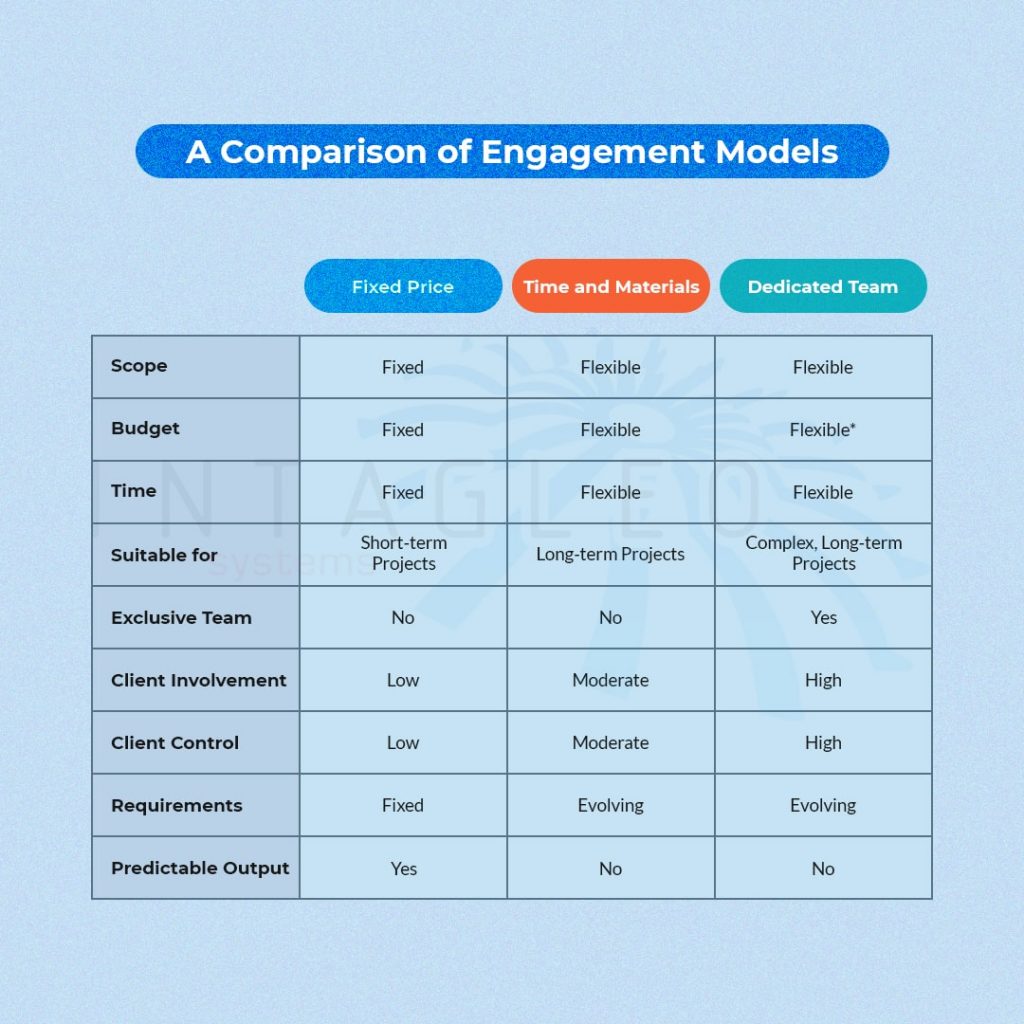
Still Not Sure Which Engagement Model Is Right for You?
Don’t worry, we’ve got you covered! With over 15 years of experience in Risk-free Outsourcing and thousands of satisfied clients around the world, we at Intagleo have what it takes to accurately scope down your needs and help you find an engagement model that works best for you.
Share your big idea with our team today, and we’ll have your project up and running in no time.


